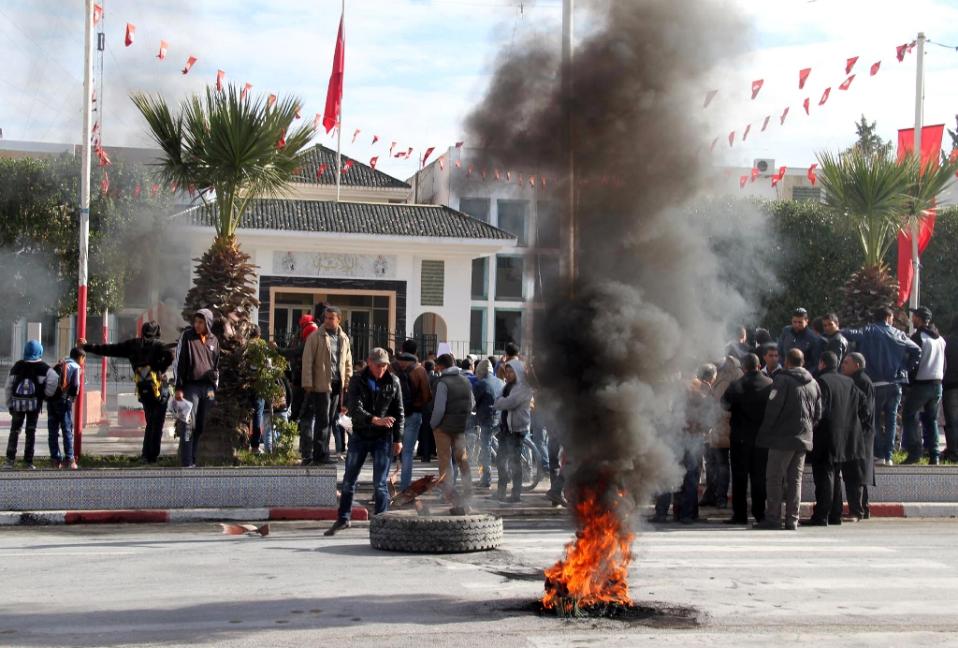Nearly a week has passed since protests broke out in the western Tunisian town of Kasserine following the death of Ridha Yahyaoui, a university graduate, allegedly threatening suicide after being denied a government job.
Eyewitness accounts report clashes between security forces and demonstrators as police is using tear gas and, allegedly, rubber bullets. In some areas, army units have been deployed to stem the unrest, while Tunisian authorities declared a nationwide curfew in response to the growing unrest.
The protests have spread to at least 16 governorates, including the capital Tunis, as crowds reportedly continue to chant: “Work, freedom, dignity,” evoking memories of the nation-wide demonstrations in 2011 that led to the toppling of longtime autocrat Zine el-Abedin Ben Ali.
In Tunis, demonstrators demanding jobs and development even broke into and occupied the headquarters of the governorate of Greater Tunis. The marches were made up of several civil society groups including the Tunisian General Student’s Union (UGET), the Union of Unemployed Graduates (UDC) and the Popular Front – a coalition of leftist forces.
Speaking to Tunisia Live, Souheil Aidoudi, a member of the executive office of the UDC, said that the objective of the protests is to “continue with revolutionary action due to the worsening socio-economic situation, plus the plague of unemployment that has visited Tunisia … we have the same demands for dignity, employment and freedom that they have in Kasserine, Siliana and elsewhere.”
The government has tried to calm the situation by promising to hire 5000 unemployed individuals and to form a “national committee” aimed at tackling the problem of corruption.
While Tunisia is often hailed as the only success story of the popular revolutions that came to be known as the Arab Spring, the ongoing civil unrest highlights the social and economic grievances that sparked the 2011 revolution have yet to be remedied, five years on.
ROOTS OF THE JASMINE REVOLUTION
What happened in Tunisia in 2011 was first and foremost a political revolution. Ben Ali, who had ruled the country since 1987, was overthrown, which initiated a process of political transition culminating in the holding of parliamentary and presidential elections and the writing of a brand new constitution.
From the viewpoint of many governments and media outlets in the West, the transition to electoral democracy was more or less achieved with Ben Ali stepping down. While the political transition precipitated the portrayal of Tunisia as the region’s “only success story” it simultaneously ignored the deep roots of the 2011 protests, which in essence were social and economic.
ECONOMIC REFORMS AND ITS EFFECTS
In addition to the severe democracy deficit, rampant corruption, and violent repression of dissidents by the Ben Ali regime, one of the main underlying causes of the Tunisian revolt is found in the effects of the IMF and World Bank-inspired market reforms initiated in the late 1980s. These structural adjustment policies comprised large-scale privatization, trade and price liberalization, and significant reductions in public expenditures, including subsidies on consumer goods and state-sector employment.
The aim of these policies was to transform the economy from being state-dominated to one driven by the private sector. The reforms also included the reorientation of the economy towards exports – e.g. in manufacturing, agricultural production, tourism – which exposed the country to the brutal competition of the international market.
As these emerging economic sectors primarily required an unskilled workforce, Tunisia’s skilled workers had increasing difficulties finding employment. The situation became particularly worrisome for Tunisia’s many higher-level graduates, who poured out of universities without being able to find work.
Like many states in the Middle East, Tunisia under Ben Ali was characterized by what is sometimes called patrimonialism, which in essence means that state power is monopolized by a small ruling clique, often comprised of the family of the ruler. This small group surrounding Ben Ali benefited greatly from the liberalization of the economy. In fact, there emerged a new enriched class of businessmen that reaped the profits of the new private enterprises. At the same time, job creation by these same companies remained low.
As a result, social and income inequality and poverty rates increased considerably and the living standard of the middle class deteriorated.
RURAL-URBAN DIVIDE
In addition to the nation-level increase in social disparities resulting from the economic liberalization process, spatial inequalities between Tunisia’s urban core and rural periphery also grew.
Tunisia’s coastal areas – where the majority of the country’s labor-intensive industrial production and tourist industry are located – received significant amounts of public and private investment resources as part of the restructuring of the economy. However, the inland and rural regions – particularly in the west – were neglected and therefore did not receive an equitable share of the country’s economic growth. As a result, income and consumption levels there were – and continue to be – considerably lower, corresponding with a higher rate of poverty and unemployment. In fact, poverty in the rural areas is “about 50 percent higher than the national average and more than twice the rate seen in large cities,” a 2014 Brookings report concluded.
This also helps to explain why the 2011 revolt erupted where it did. It is admittedly true that, since the 1970s, the Midwest town of Sidi Bouzid went through a process of agricultural development whereby its economic activities were transformed from being based on low-yield cereal production and semi-nomadic sheep herding to profit-driven intensive irrigated farming. However, the farming profits were largely transferred to wherever the outside investors’ home regions were located and so the local population did not really benefit from this development.
Furthermore, while agriculture constitutes around 70 percent of Sidi Bouzid’s economy, the large number of young people with university educations did not manage to find suitable jobs. In fact, according to the Brookings report cited above, 40 percent of university graduates were unemployed in 2010, which further helps explain why the protests were dominated by the youth.
Kasserine, where the currently ongoing protests were sparked, is – much like Sidi Bouzid – part of Tunisia’s rural periphery. It has for long been marginalized and neglected in terms of government investments and, like other inland towns, unemployment and poverty are rampant. In fact, Kasserine was one of the first towns after Sidi Bouzid to rise up in 2011.
MODEST CHANGES SINCE 2011
Although Tunisia has made significant progress towards a more democratic and equitable system since the Jasmine revolution, that progress has primarily occurred in the political sphere. The lid on freedom of expression has been lifted, free and fair elections have been held and one of the world’s most progressive constitutions – having provisions on climate change and women’s rights – has been ratified.
But the root causes of the 2011 uprising have not been addressed to a similar degree. The unemployment rate has risen from roughly 13 percent in 2010 to over 15 percent today. And that is only the official figures. Moreover, while the economic growth in 2010 was 3.5 percent, the figure for 2015 was only 0.5 percent.
The protesters in Kasserine and elsewhere are blaming President Caiji Essebsi and his Nidaa Tounes party for only implementing cosmetic measures.
Tareq Toukabri, member of the youth movement “The Movement of the New Generation” commented on the government’s promise to create 5000 new jobs in Kasserine saying: “This is only a cosmetic solution that has no basis in reality. If you employ 5000 men from Kasserine, then 5000 more from Baja will rise up. They have the right to employment. It’s the same case with Sidi Bouzid.”
The main problem appears to be that the current government is attempting to improve the situation for Tunisians within the economic framework that the old regime instituted. It is clear that the 2011 events were the result of a structural crisis, not a temporary one. In that light, Tunisia – and other countries in the region – must radically change the structural base of their socio-economic systems. Hence, the removal of Ben Ali and the subsequent political democratization could never be enough and would doubtlessly lead to further upheaval.
In that sense, it is instructive to understand the period beginning with the Jasmine uprising as a long-term revolutionary process that would not take weeks or months, but rather years or decades to complete.
With revolution always comes reaction, and in light of the unprecedented chaos the Middle East is witnessing at the moment it is arguably the case that reaction is the current status of that long-term revolutionary process.
But it is not unimaginable that, five years after the Arab Spring, Kasserine may be the town igniting another wave of revolutionary upheaval in Tunisia and across the region.







Comments (0)